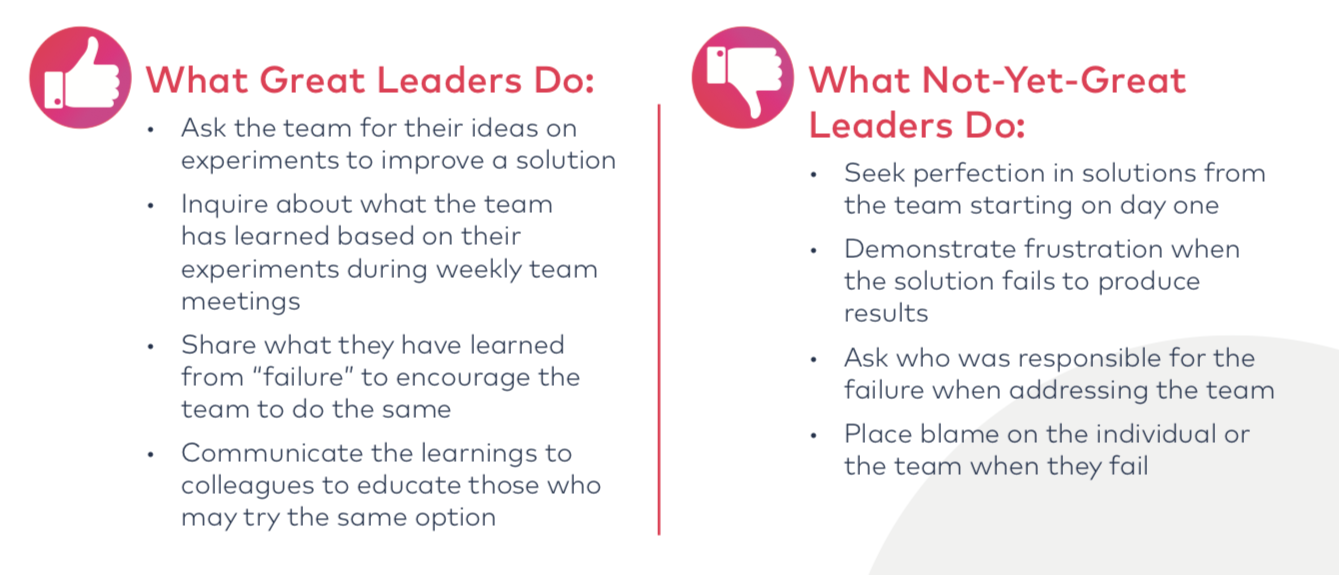
Culture change: The magic of transformational moments
Written by David Bernal, Senior Director, and Kathryn Clubb, Managing Director
Transform or become irrelevant
Today the fastest innovators and most customer-focused companies, without regard to industry or product, are shaping customer expectations for all. Product company, industrial company and especially service company offerings are compared to the “prime” experiences people have as customers elsewhere. The consequences of not keeping up with customer expectations are irrelevance, loss of market share and stagnant growth – or worse.
While the solutions are clear – listening to the customer, using data intelligently, experimenting to test and adjust, and leveraging technology to make it all happen – how to effectively implement these solutions and realize change is often ambiguous. Once an organization determines what change is needed to stay competitive in the marketplace, the typical first steps are structural shifts in processes, technology, and organizational design, and increased investment in technology and technology professionals. In relative terms, that is the easy part of the transformation. But it’s not all that is necessary.
The future is not just a smarter, faster, better version of the past
The levels of uncertainty about what to do and how to behave in the face of major transformation can be very high and provoke stress reactions of fight, flight or freeze in their corporate forms. Fight, or resistance, is rarely overt in organizations; it may look like intelligent questioning or expressing doubts in ways that subtly undermine organizational efforts and leadership messages.
Flight is often the easiest option for employees, especially when the economy is strong. In a world where the workforce is more mobile, protracted uncertainty takes its toll on the best employees, who will leave to join companies giving them a clearer future. But the most common response is to freeze, either by doing nothing or by doubling down on what has always been done; frozen in the past.
When employees understand the reason and feel the urgency for change, being frozen in old habits and actions can get even more challenging and complicated. Feeling the pressure to do something different and faster, they act. However, their instincts are shaped by the culture, mindsets and habits that were built in, and for, the past. Well-meaning employees frenetically trying to force their actions and habits of the past into the requirements of the future are rarely successful and often counterproductive to company goals.
In the business context, an individual’s mindsets and habits are held in place by the company’s deep-rooted organizational culture. In the simplest form, culture can be thought of as the core of the company’s “human operating system.” Why is that?
While people can see the why and what of change, they are habituated to past behaviors and practices. It takes enormous effort to truly act in ways consistent with the change; you can’t just force behavior change or it will fall apart when employees, teams and the entire company are under stress.
The current culture presents a dominant force against change. A fundamental culture shift needs to happen for employees and leaders to work in new ways that support the overall transformation. Without this shift in culture, the transformation will fall flat and fail.
Traditional methods for behavior change are not enough
Conventional change management and people process changes are rarely “personal” enough to achieve the transformational aspirations of a company’s leadership. To “get” culture change, employees need to see themselves in the envisioned future, understand when to behave differently and, at least at first, be guided to the right actions.
The problem is, revamping values or building new competency or capability frameworks to describe the new ways of working are only meaningful to the people who build them – which is usually HR. Describing a series of behaviors around those updated values or frameworks can increase clarity of expectations on the job, but such tools are used infrequently and often out of context for individual employees.
Some organizations will take a step further and integrate those models into HR systems (e.g., selection, performance management, promotion, HiPo identification) as leverage points to shape the new culture, but the primary users are HR professionals – people managers and other leaders only get episodic exposure to them. While integrating the models is the right move to reinforce culture and behavior change, it takes time for those systems to become visible to employees and impact their behaviors, and even more time to impact the collective culture. Unfortunately, time is in short supply when undergoing a transformation; competitors are relentless, and customers are unforgiving.
Show them what the new way of working looks like
Organizations need to be very clear on the tangible changes they want to achieve when undergoing a transformation. They need to paint a clear picture not only how to get the work done and what behaviors are necessary to doing so, but also, more importantly, when employees must demonstrate those new behaviors. In every employee’s daily life there are critical moments in which the new behaviors must be applied in ways that support the transformation and drive adoption of the new culture. In recent work with clients, we have found that codifying selected pivotal moments for employees helps them recognize when they need to act differently to achieve different results.
An example of transformational moments: When the team fears failure
Over the years, we have worked with multiple organizations across industries as they have undertaken digital transformations to increase speed, expand innovation and satisfy customer demands. Often this includes moving from a serial way of working (i.e., waterfall approach) to a dynamic manner (i.e., Agile) to deliver solutions to customers faster. Such change has huge implications on how work is completed on a day-to-day basis. Leaders managing teams working in this new way often struggle with the new, and very different, expectations of them as leaders.
In most organizations, people are afraid to make mistakes or errors, as they think mistakes are perceived as a lasting mark against them and making too many mistakes can translate into low performance reviews, or even termination. In reality, the consequences of making mistakes are rarely as draconian as company lore would suggest. But whether real or perceived, those dire consequences are the antithesis of new “test and learn” environments that need to thrive for the Agile approach to work.
To foster experimentation, employees must be comfortable trying new things and risking failure – which requires leaders to change their ways of reacting to mistakes. Lessons from mistakes must be considered additional data points to inform actions in the future, and part of the process to build a better solution. The entire “test and learn” process will fail to produce results if employees are fearful of trying new ideas. Managing in this moment requires a huge behavior shift for leaders, and they need guidance on what to do and not do in order to encourage the team to move beyond their fear of making mistakes.

What Great Leaders Do:
- Ask the team for their ideas on experiments to improve a solution
- Inquire about what the team has learned based on their experiments during weekly team meetings
- Share what they have learned from “failure” to encourage the team to do the same
- Communicate the learnings to colleagues to educate those who may try the same option
What Not-Yet-Great Leaders Do:
- Seek perfection in solutions from the team starting on day one
- Demonstrate frustration when the solution fails to produce results
- Ask who was responsible for the failure when addressing the team
- Place blame on the individual or the team when they fail
There is a common saying in the business world today: “Fail fast, learn faster.” Sometimes that’s all leaders know they should be doing to change their habitual behavior. But this is neither personal enough nor contextual enough to give them specific examples of how to handle failure in a way that helps the company transform.

The magic of transformational moments
To reduce the resistance of the fighters, calm down the potential “flee-ers” and unfreeze the frozen, find transformational moments and uncomplicate what is expected of leaders and employees.
Help them know when to change their behavior by identifying those moments critical to business success experienced by many employees as leverage points for culture change.
Show them the actions in those moments that will reinforce the desired culture, demonstrate the benefits of working in the new way and create coherence between what leaders say and do.
Focus on those few moments to create the trigger for employees to remember that some different behavior is required of them. Describe what great and not-yet-great behavior specifically looks like in that situation to give the employee a timely and relevant guide for what to try, do and practice.
When entire levels of leaders or groups in a company start working in new ways around these transformational moments, culture change happens.
This article also appears on bts.com:
Culture Change: Activating New Ways of Working through Transformational Moments
 BTS, an Advantage Performance Group thought leader partner, is a global professional services firm headquartered in Stockholm, Sweden, with some 500 professionals in 33 offices located on six continents. We focus on the people side of strategy working with leaders at all levels to help them make better decisions, convert those decisions to actions and deliver results.
BTS, an Advantage Performance Group thought leader partner, is a global professional services firm headquartered in Stockholm, Sweden, with some 500 professionals in 33 offices located on six continents. We focus on the people side of strategy working with leaders at all levels to help them make better decisions, convert those decisions to actions and deliver results.
Kristopher Roller
- Strategy is like a bag of beads - November 29, 2018
- Customer story: Cultivating culture change at Citizens Bank - August 17, 2018
- Culture change: The magic of transformational moments - May 9, 2018

